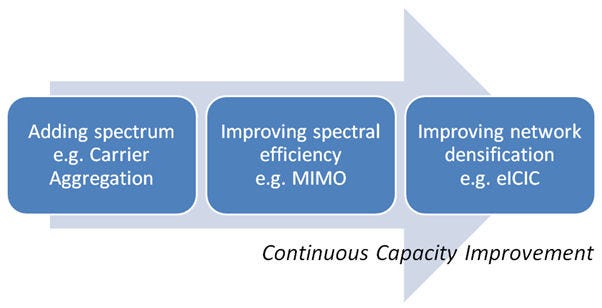Carrier Aggregation – one of most popular features of LTE-Advanced – is currently in the innovator and early-adopter stages of the technology lifecycle. As such it is still relatively immature and complex to implement with the risk of disappointing early consumers.
October 29, 2014

Telecoms.com periodically invites expert third-party contributors to submit analysis on a key topic affecting the telco industry. In this piece Richard Jacklin, Head of Business Development at Anite, takes a closer look at carrier aggregation and how to ensure it delivers on its promise.
Carrier Aggregation – one of most popular features of LTE-Advanced – is currently in the innovator and early-adopter stages of the technology lifecycle. As such it is still relatively immature and complex to implement with the risk of disappointing early consumers. By conducting comprehensive testing in the early R&D stages, manufacturers are able to ensure a key feature like Carrier Aggregation doesn’t result in carrier aggravation!
Carrier Aggregation (CA) is designed to increase user download or upload data speeds by adding spectrum blocks together. The spectrum blocks – more commonly known as component carriers – are allocated from different bands (inter-band) or within the same band (intra-band). By using two or more component carriers, with a typical bandwidth of either 10 MHz or 20 MHz, a wider aggregated data pipe is created. As a result, end-users benefit from much greater data rate speeds required for higher definition video streaming, device tethering and as an alternative to cable-based broadband.
We should expect to see many other features in LTE-Advanced – some will be used and others will perish in an unused ‘feature graveyard’. One feature that is currently receiving a lot of attention is higher order MIMO (Multiple Input Multiple Output) antenna configurations. MIMO effectively improves the spectral efficiency and data throughput by using multiple transmit and receive antennas. Whereas LTE release 8 launched MIMO configurations of 2×2 (two transmit and two receive antennas), LTE-Advanced supports up to 8×2 MIMO, depending on the size of the mobile device. Higher order MIMO combined with CA technology in trials are demonstrating peak data speeds of up to 450Mbps in many places around the globe, including Western Europe, North America and Asia-Pacific regions.
Another popular LTE-Advanced feature, is enhanced Inter-cell Interference Coordination (eICIC) that aims to improve network densification. This feature deals with interference issues in Heterogeneous Networks (HetNet) where LTE networks are formed from using a combination of wide-area macro cells and local area small cells. HetNets operate on the same frequency channel and eICIC uses various radio and channel techniques and a concept of Absolute Blank Sub-frames to mitigate interference on the user and control plane data. It is forecast that small cell equipment revenues will grow by over 30% in 2014, on the back of major mobile operators driving deployment.
Using LTE-Advanced features to improve capacity
There is a colossal need to increase capacity and speed to the end-user through the use of applications including video-on-demand, web browsing, audio streaming and machine-to-machine communications. LTE-Advanced and its key features like Carrier Aggregation, MIMO and eICIC support these requirements, which are expected to grow exponentially with the introduction of 5G. As this higher capacity channel matures, we will also see the growth of Voice over LTE (VoLTE) as well as the emergence of applications we haven’t yet even dreamt of.

Addressing the challenges of adopting LTE-Advanced features
So what are the challenges in successfully adopting LTE-Advanced features and how do we realise the potential in the standards produced by 3GPP? So far, LTE-Advanced is defined by 3GPP Releases 10 and 11, with Release 12 soon to be issued. Any 3GPP release typically includes many feature additions that constantly evolve mobile devices, radio and core infrastructure. These enhancements along with the conformance test specifications are used to validate the system operation and performance. By adopting an end-to-end validation process that encompasses all the individual pieces in the system – devices, radio and core infrastructure – some of the key challenges, outlined below, can be successfully addressed.
Let’s start by looking at the device: We have already described how CA can be made up of a combination of different channel bandwidths, coupled with different band usage either intra or inter, along with a variable number of component carriers, all with various modes of MIMO. To complicate matters further, there can also be a choice and combination in channel duplexing either Frequency (FDD) or Time (TDD), transmission mode and IP data transfer mode. All these variables can quickly create an exponential number of combinations that need to be designed correctly and most importantly tested and proven.
Preparation is key in order to ensure device testing is carried out as efficiently as possible. Manufacturers of new mobile devices benefit from initiating testing at the earliest possible point in the R&D cycle when issues are easier and not as expensive to resolve. Development and test time can be significantly reduced by implementing 24/7 device testing automation and by making the most of test systems by demanding stability and reliability from the test vendor. Finally, by selecting an easy to use test system, time relating to configuring and controlling can be greatly reduced.

Looking at CA on the infrastructure side of the wireless test system, the Radio Access Network (RAN) offers a number of test challenges. CA RAN testing requires various configurations; one or several devices, mobility scenarios, MIMO antenna combinations as well as radio channel emulation on a per CA band basis. RAN is typically tested with test mobiles or real devices together with a Channel Emulator that reliably reproduces the multi-path and faded characteristics of a real radio channel. The choice of Channel Emulator is critical to optimising RAN Carrier Aggregation testing. Important factors to consider include: high radio channel density for MIMO and multiple devices or RAN, ability to handle different CA inter-band frequency combinations, high bandwidth for intra-band combinations and interference generation to test eICIC scenarios.
Finally, we need to see the overall LTE-Advanced performance end-to-end. A common way of getting a bird’s eye view is to monitor and measure the overall traffic and loading through the core network. Core Network Analysers provide statistics of overall LTE-Advanced signalling and user traffic flowing through the RAN and core network. These tools view the build-up of latency in heavily loaded areas and also help diagnose interoperability (IOT) issues. Monitoring specific users and drive test mobiles help to establish a useful picture of the overall performance. This type of core network testing in a secure IOT environment also provides dividends before live deployment.
We are still in the early phases of LTE-Advanced with features such as Carrier Aggregation, eICIC and MIMO. As we transition through to 4 or 5 component carriers or 8×8 MIMO, enabling speeds beyond 1Gbps, the test and proving strategy will become even more essential in order to meet end-users’ expectations.
 Richard joined Anite in 2007 to manage the SAS product line. He has since become Business Development Director, responsible for developing and executing the company’s strategic growth initiatives. His extensive career in wireless telecoms has included roles at many leading companies including Samsung, Ericsson and RFI-Global.
Richard joined Anite in 2007 to manage the SAS product line. He has since become Business Development Director, responsible for developing and executing the company’s strategic growth initiatives. His extensive career in wireless telecoms has included roles at many leading companies including Samsung, Ericsson and RFI-Global.
Richard is a Chartered Engineer, Fellow of the IET, and holds an honours degree in Electronic Engineering from the University of Portsmouth.
Read more about:
DiscussionAbout the Author(s)
You May Also Like








.png?width=300&auto=webp&quality=80&disable=upscale)


_1.jpg?width=300&auto=webp&quality=80&disable=upscale)


.png?width=800&auto=webp&quality=80&disable=upscale)